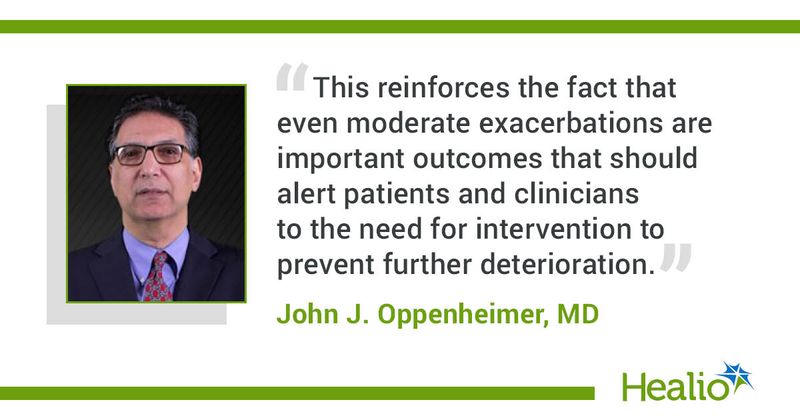Moderate asthma exacerbation effects may be just as significant as severe ones
Key takeaways:
- Moderate exacerbations shared similar characteristics with severe exacerbations.
- Lung function, limitations and SABA use returned to baseline after 8 to 12 days for both exacerbation severities.
Moderate and severe asthma exacerbations differ in changes in lung function and clinical characteristics, but are similar in onset and time to resolution, according to a study in The Journal of Allergy and Clinical Immunology: In Practice.
“We know that exacerbations have significant sequela both from patient health and health care resource perspectives,” John J. Oppenheimer, MD, clinical professor of medicine at UMDNJ Rutgers University School of Medicine and allergist at Pulmonary and Allergy Associates NJ, told Healio.

“Thus, better understanding the strata of exacerbations is of great interest. With CAPTAIN’s large data pool of exacerbations, this provided a great opportunity to mine the data,” said Oppenheimer, who also is a member of the Healio Allergy/Asthma Peer Perspective Board.
Methods
The CAPTAIN trial was a phase 3A 24- to 52-week, multicenter, international, randomized controlled trial that evaluated the efficacy and safety of fluticasone furoate/umeclidinium/ vilanterol (FF/UMEC/VI) vs. FF/VI in patients with uncontrolled asthma who were on inhaled corticosteroids or long-acting beta2 agonists.
Of the 2,436 patients within the intent-to-treat (ITT) population, 1,097 (45%) continued the study for more than 24 weeks, 547 (22%) completed 36 weeks and 550 (23%) completed 52 weeks.
Researchers defined a moderate exacerbation as one that lasted at least 2 days and required a physician-directed temporary change in maintenance therapy. The need for systemic corticosteroids, at least doubling a maintenance systemic corticosteroid dose for a minimum of 3 days or the need for an ED visit/hospitalization for asthma with systemic corticosteroids were used to define severe exacerbations.
Results
In the ITT population that was analyzed from week 1 to 24, 1,881 (77.2%) had no exacerbations, 244 (10%) had moderate exacerbations, 260 (10.7%) had severe exacerbations and 51 (2.1%) had both. Those without vs. with exacerbations had less severe disease at baseline.
Patients with no exacerbations also exhibited higher home daily trough FEV1 and morning peak expiratory flow (PEF) values, as well as lower symptom scores and short-acting beta agonist (SABA) use. Patients with both moderate and severe exacerbations (n = 51) had the lowest trough FEV1 and morning PEF values and the highest symptom scores and baseline rescue medication use.
Patients with severe or both moderate and severe exacerbations demonstrated a trend toward having higher baseline levels of type 2 inflammatory biomarkers, eosinophils and fractional exhaled nitric oxide. Results were similar for participants who participated from weeks 1 to 52.
Also within the ITT population examined from week 1 to 24, 295 (12.1%) patients had at least one moderate exacerbation and 311 (12.8%) had at least one severe exacerbation. Results were similar in the 52-week patients, in which 390 patients (16%) had 529 moderate exacerbations with a median duration of 9 days, and 390 patients (16%) had 546 severe exacerbations with a median duration of 10 days.
Researchers found that those patients with an initial severe exacerbation were more likely to experience one as a second event, whereas those who experienced an initial moderate exacerbation were more like to have another moderate exacerbation.
Over the 14-day peri-exacerbation period for moderate and severe exacerbations, home daily trough FEV1 and morning PEF began to decline at around 4 to 6 days before day 0, with the daytime asthma symptom score, SABA use and physical activity limitation score going up around 2 to 3 days before the exacerbation. It took around 8 to 12 days for the scores to return to baseline after the event.
“It was interesting to note that the onset, resolution and spiro decay was similar between moderate and severe exacerbations,” Oppenheimer said. “I would have thought greater reduction in spiro and longer time to resolve in more severe exacerbation. The question is why the difference in symptom severity.”
Oppenheimer further explained that both moderate and severe exacerbations had very similar characteristics with regard to onset and time to resolution as well as decay in lung function.
“Severe exacerbations, however, did have slightly great symptoms, SABA use and impact on physical activity,” he said. “This reinforces the fact that even moderate exacerbations are important outcomes that should alert patients and clinicians to the need for intervention, to prevent further deterioration.”
When asked about future research, Oppenheimer told Healio that “further work is needed to determine why [there is a] disconnect between symptoms and spiro, onset and resolution of exacerbation.”
